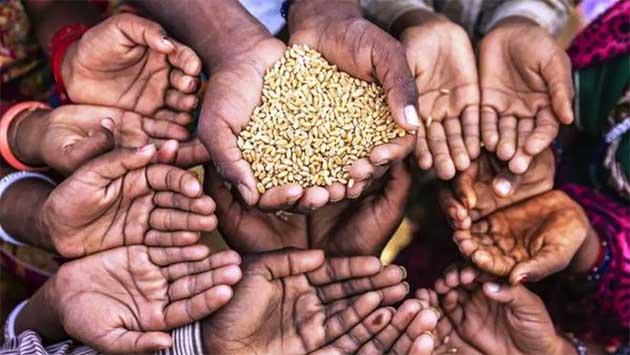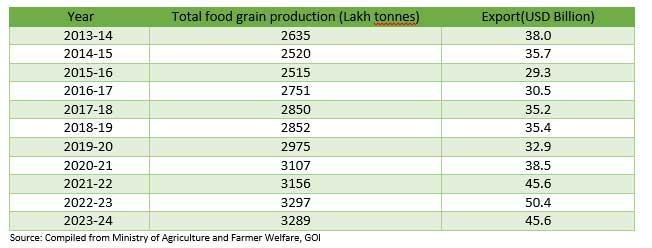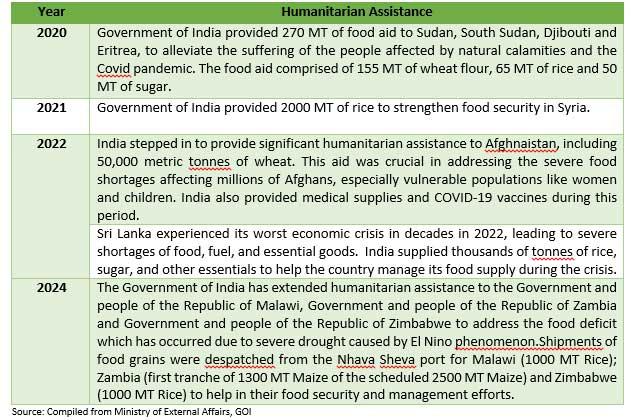24 Sep 2024 - {{hitsCtrl.values.hits}}
 India's progress in achieving food security is a story of resilience, determination, and strategic interventions. The country has not only reached self-sufficiency in food production but has also become a key exporter of food grains, especially during global crises. With surplus food stocks, India has been able to extend support to other nations in times of emergency.
India's progress in achieving food security is a story of resilience, determination, and strategic interventions. The country has not only reached self-sufficiency in food production but has also become a key exporter of food grains, especially during global crises. With surplus food stocks, India has been able to extend support to other nations in times of emergency.
Food security is built on three interconnected pillars: availability of food, access to food, and the absorption of food. In India, these pillars are supported by robust policies, extensive programs, and significant investments that have enabled the country to move towards self-reliance in food security.
India's journey toward ensuring the availability of food began with the Green Revolution in the 1960s and 1970s, a turning point in the country's agricultural history. The introduction of high-yielding varieties of rice and wheat, coupled with improved irrigation practices and the use of fertilizers and pesticides, significantly increased food production. This surge in agricultural productivity transformed India from a food-deficient nation to one that could not only feed its population but also export surplus grains.
Today, India is the world's largest producer of milk, pulses, and jute, and ranks as the second-largest producer of rice, wheat, sugarcane, groundnut, vegetables, fruits, and cotton. The maintenance of buffer stocks ensures that food is available even in times of crisis. These strategic reserves help stabilize prices and prevent food shortages during emergencies, thus playing a crucial role in maintaining food availability.
Food grain production in India and agriculture exports

India's food grain production saw a significant increase from 2,635 lakh tonnes in 2013-14 to 3,289 lakh tonnes in 2023-24. Even during the challenging post-COVID period, food grain production rose from 2,975 lakh tonnes in 2019-20 to 3,107 lakh tonnes in 2020-21. This growth underscores India's self-sufficiency in food and highlights the nation's resilience in ensuring food security during the pandemic. Despite global disruptions, India managed to remain self-sufficient and continued to export agricultural products. Agricultural exports grew from USD 32 billion in 2019-20 to over USD 38 billion in 2020-21, surpassing USD 50 billion in 2021-22.
The Indian government has implemented various programs to ensure that food is accessible to all sections of society, particularly the economically vulnerable.
The National Food Security Act (NFSA) of 2013, also known as the Right to Food Act, is a landmark piece of legislation that aims to provide subsidized food grains to approximately two-thirds of India's population. This Act marks a significant shift from a welfare-based approach to a rights-based framework, legally entitling up to 75% of the rural population and 50% of the urban population to receive subsidized food grains through the Targeted Public Distribution System (TPDS).
The NFSA and TPDS, along with programs like PM Poshan and the Wheat-Based Nutrition Programme (WBNP), play a critical role in ensuring food security for millions of Indians. By distributing wheat and rice to vulnerable populations, the government guarantees consistent access to basic staples, addressing both food availability and affordability. This strategic food distribution system not only strengthens India's food security but also aids in poverty alleviation, improves nutritional outcomes, and supports broader economic stability by ensuring that food remains accessible and affordable even during crises.
The government is providing free food grains to more than 81 crore beneficiaries, including Antyodaya Anna Yojana (AAY) households and Priority Households (PHH). This initiative falls under the Pradhan Mantri Garib Kalyan Anna Yojana (PMGKAY). This large-scale distribution helps shield low-income and marginalized communities from food price volatility and inflation, ensuring they have access to sufficient and nutritious food. Programs like PM Poshan, which specifically target schoolchildren, contribute to improved educational outcomes by ensuring that children are well-fed and able to focus on learning.
The TPDS is the backbone of India's food distribution mechanism, delivering food grains at subsidized prices to eligible households. The system protects the poor and vulnerable from price volatility due to inflation, ensuring that food remains within their economic reach. Over the years, while government spending on food subsidies has increased, the proportion of people living below the poverty line has decreased, highlighting the effectiveness of this program.
Other significant programs include the Mid-Day Meal Scheme, which provides nutritious meals to schoolchildren, and the Integrated Child Development Services (ICDS) Scheme, which focuses on the nutritional needs of children under six years of age, pregnant women, and lactating mothers.
There is a growing commitment to tackling "hidden hunger," where individuals meet their calorie needs but may lack vital vitamins and minerals. To address this, the government's focus is increasingly on enhancing food quality and encouraging dietary diversity. The government's swift response, including distributing free food grains to vulnerable populations during the pandemic, helped mitigate the impact significantly. To further strengthen food security, the government is investing significantly in agricultural research and development to develop high-yield and climate-resilient crop varieties, promoting sustainable farming practices such as organic farming and precision agriculture.
India has not only achieved self-sufficiency in food production but has also emerged as a key exporter of food grains, especially during times of global crises. Decades of agricultural reforms, such as the Green Revolution in the 1960s, transformed the country from a food-deficient nation to one of the world’s largest producers of staples like rice and wheat. Today, India ranks among the top global producers of cereals, pulses, and sugar, ensuring food security for its population of over 1.4 billion people.
With surplus food stocks, India has been able to extend support to other nations during emergencies. Its well-established food security programs, such as the Public Distribution System (PDS) and schemes like the Pradhan Mantri Garib Kalyan Anna Yojana (PMGKAY), ensure that the domestic population has access to food during challenging times. Simultaneously, India exports significant quantities of rice, wheat, sugar, and pulses to countries facing shortages.
India’s Food support to countries during the time of crisis.

During the COVID-19 pandemic, India stepped up as a reliable supplier of food grains to nations affected by supply chain disruptions. Similarly, when countries like Afghanistan, Sri Lanka, and Lebanon faced severe crises, India provided both humanitarian aid and food supplies, reaffirming its role as a global partner. This dual capability—ensuring domestic food security while supporting international needs—highlights India’s growing importance in global food supply chains.
In conclusion, India's journey toward self-reliance in food security is a testament to the power of strategic planning, robust policies, and effective implementation. While challenges remain, the country's progress in increasing food availability, improving access, and enhancing absorption has laid a strong foundation for future growth. Strong investments in agriculture, infrastructure, and social safety nets ensure that all citizens have access to adequate and nutritious food, thereby fulfilling the right to food and contributing to the country’s overall socio-economic development and high economic growth trajectory.
04 Dec 2024 04 Dec 2024
04 Dec 2024 04 Dec 2024
04 Dec 2024 04 Dec 2024
04 Dec 2024 04 Dec 2024
04 Dec 2024 04 Dec 2024